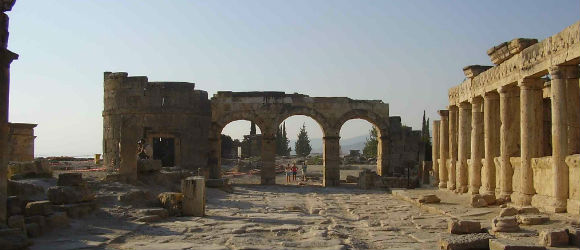The presence of a hot spring at Hierapolis and the spectacular calcium deposits from its water spilling over the nearby hillside suggest that there should be evidence of an early settlement there. The oldest Inscription found so far, however, indicates it was founded by Eumenes II, king of Pergamon, in the latter part of the second century B.C.; it soon became a busy industrial center.
Pagan worship in the city centered around Cybele, Apollo, Artemis, Men, Poseidon, and Pluto. Underneath the Temple of Apollo has been found the Plutonium, an opening in the earth from which a noxious gas still comes. The temple is between the pool where the hot spring rises and the large theater on the side of the hill. To the north along the rim of the plateau is a long avenue of tombs.
Traditionally St. Philip is connected with the early church in Hierapolis. Fairly recently Italian archeologlsts have discovered his Martyrium, an octagonal chamber forming a double cross surrounded by a square. This is almost due north of the theater, also on the side of the hill. It was a fifth century A.D. building and did not last much more than 100 years. No tomb was found with it although that was expected. There are several ruins of churches, one not far from the baths, one on the main road leading to the necropolis.
Hierapolis is listed in the New Testament along with Laodicea as the center of Epaphras’s work (Colos-sians 4:13). This was at the time Paul was writing to strengthen the message Epaphras was preaching and to condemn the “people who go in for self-mortification and angel-worship” (Colossians 2:18). Another less well-known resident of Hierapolis was Papias, a disciple of St. John and the author of the lost book called the Sayings of Jesus.
While Epaphras was is that area, a young slave was growing up in Hierapolis, a boy whose original name is unknown but whom we call by the Greek for “Acquired”, Epictetus. In his Discourses Epictetus often talks about the perfect missionary whose bed was the ground, whose only house the earth and sky and a shabby cloak, and who must love those who misuse him in the service of God. One wonders what the influence of those early Christians, many of whom were slaves themselves, was on this Stoic philosopher.
Hierapolis,


Very comprehensive and well preserved historical site that's fascinating to walk through – be sure to hike up to the stadium on the hill.
The ruins of Hierapolis are extensive and interesting. We wished we'd had more than a couple of hours to spend but really enjoyed exploring them. Of course it's great to include a swim in the "Antique Pool" while you're there.
Pamukkale is several hours drive inland from the Turkish coastal city of Kusadasi. It's a long drive there and back, but worth it. The site is best reached by taking a tour. We arranged a private car and guide, which is costly but allowed us to visit the ancient city of Aphrodisias along the way, and to avoid the normal…
'Beautiful' was the first thing that comes to mind upon our first glimpse of the white travertine hill while our bus approached the huge Hierapolis (meaning 'Holy City' in ancient greek) historical park. As part of our Turkey tour package, we didn't have time for the entire park and it's ruins, but we did spent 1.5 hr mainly to enjoy…
Pamukkale (Cotton Castle), is considered today the eighth wonder of the world. It is presumed that the travertines were formed in the course of a process which lasted 15 thousand years. As the water, having a temperature of 34 degrees Calcius, gushing from the underground springs at an elevation of 160 m off the plain of Menderes, with calciumbicarbonate content,…
Very noce site, you are coming here to see Pamukkale Thermal pools but when you are here you cannot miss also Hierapolis. The best thing in my opinion is its necropolis
We visited that great place of Turkye in August 2010. Hierapolis was an important citadel and also an important religious center. The entire zone is full loaded with history and many archeological sites. But what attracts like a magnet the people it is the huge area which I called White Sea. The waters are leaving its dregs on a platform…
We travel to look at historic sites, learn more about culture of other countries. This is one of the historical places to visit.
Hierapolis is wonderfully sited at the top of the travertines in Pamukkale, and the ruins are immense. Go early or late in the day to avoid the sun, as it gets VERY hot on the stones mid-day, and there is a lot to see; very spread out. Some limited signage available, and even though the travertines get quite a crowd,…
We travelled by car from Selcuk visiting Aphrodisias enroute to Pamukkale and Heirapolis.
Following the recommendation in our guide book we ignored the south gate and drove on up past the village to go in via the northern gate which was good advice but so far on I thought we had missed it. The Heirapolis ruins are extensive and having…